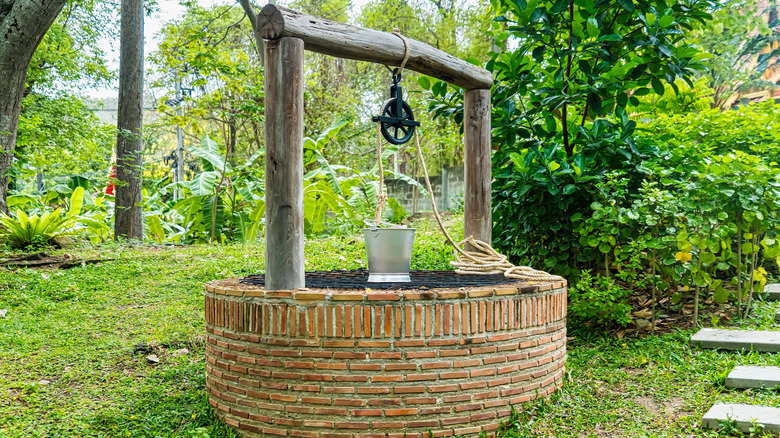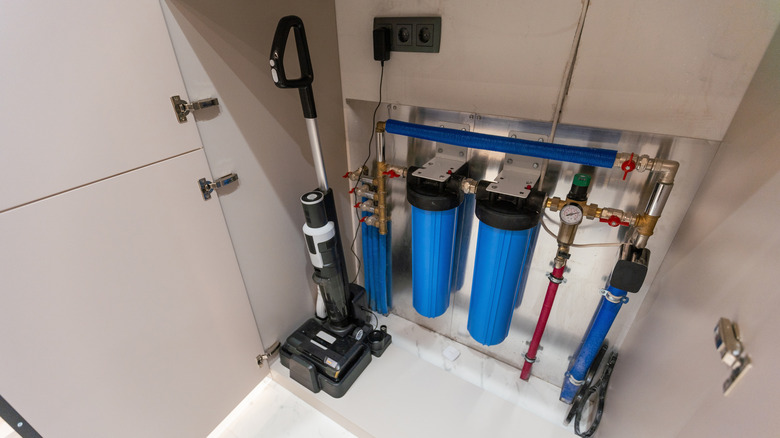How To Make Well Water Safe To Drink
If your home uses well water, you might assume it's pure because it comes from deep underground, but that's not always the case. It's different from city water, which is treated and tested regularly by local authorities. Private wells are the homeowner's responsibility, so any contamination must be checked by you. Well water can be affected by naturally occurring minerals (like iron and arsenic) as well as contaminants like bacteria, nitrates, pesticides, and heavy metals; especially if the well is shallow or located near agriculture or septic systems.
The Cleveland Clinic notes that even clear and odorless water might contain dangerous microbes like E. coli or cryptosporidium. Drinking untreated or poorly filtered well water could lead to gastrointestinal illness, reproductive issues, or other long-term health effects, particularly in children and immunocompromised individuals.
That's why the first and most critical step to making well water safe is testing it. You should have a well tested at least once a year for bacteria, nitrates, pH, and dissolved solids. If your well is near a farm, landfill, or septic system, more frequent testing is recommended. Most local health departments offer test kits or referrals to certified laboratories, as this is the only way to know for sure what's in your water. Once you know what the problem is, you can learn how to treat it effectively.
Filtration systems that make well water safe
Post-COVID, people have been very aware of what they put into their bodies. Water has proven to be a point of contention, in this regard. We're told that you shouldn't drink bottled water, you shouldn't drink water on an airplane, and so on. Checking your well is just an extension of that same preventative health care. Once well water has been tested and you know what you're dealing with, the next step is treatment.
There's not one sole solution you can turn to in every circumstance, which means the filtration system you pick should target the specific contaminants found in your well. Most homeowners need a multi-stage approach that covers multiple bases. For sediment and larger particles like sand or rust, a simple pre-filter will usually do the trick. But for more complex issues like bacteria, heavy metals, or high mineral content, you'll need a more advanced filtration system.
A common setup starts with a whole-house sediment filter followed by a carbon filter (to reduce chlorine-like tastes and organic compounds). If you have hard water (high in calcium or magnesium), a water softener may also be needed. For pathogens like E. coli or giardia, the CDC recommends a UV light purification system which kills microbes without adding chemicals.
Reverse osmosis systems can also remove nitrates, arsenic, and heavy metals, but they often work best in conjunction with other filters. In general, homeowners who've tackled this issue before say combining multiple systems offers the most protection. And while some setups may be costly up front, investing in the safety of your home's drinking water is always worth it.
Maintenance, monitoring, and long-term safety tips
Installing a high-quality filtration system is only half the battle, as keeping your well water safe requires regular upkeep. The CDC emphasizes the importance of routine maintenance for both the well and filtration components. Just like how you need to change the water filter for your fridge, you have to do the same for any other water filter system in your home. For starters, inspect the well annually to check for cracks in the casing, changes in water clarity or smell, and signs of contamination from nearby sources like flooding or agricultural runoff.
Filters and UV bulbs need regular replacement to remain effective. Neglecting this step can lead to bacteria slipping through or cause a buildup of harmful substances in your system. Most manufacturers include a replacement schedule and it's wise to log changes so nothing goes unnoticed. By retesting your water once a year — or after any major environmental change like a storm or flood — you'll be able to catch new threats early.
Long-term safety also means keeping the area around your well clean. Don't store chemicals or fuel nearby and maintain a safe distance between the well and septic system. If the well is old or shallow, consider upgrading to a deeper or sealed model to reduce the risk of surface contamination. Safe drinking water starts with awareness and ends with you taking action. If you keep up with routine testing, proper filtration, and maintenance, well water is just as safe, and often better-tasting, than municipal supplies.


